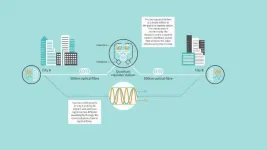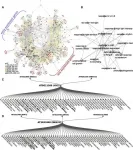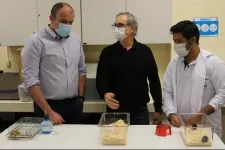(Press-News.org) An experimental, lab-made antibody can completely prevent nonhuman primates from being infected with the monkey form of HIV, new research published in Nature Communications shows.
The results will inform a future human clinical trial evaluating leronlimab as a potential pre-exposure prophylaxis, or PrEP, therapy to prevent human infection from the virus that causes AIDS.
"Our study findings indicate leronlimab could be a new weapon against the HIV epidemic," said the study's lead researcher and co-corresponding author of this paper, Jonah Sacha, Ph.D., an Oregon Health & Science University professor at OHSU's Oregon National Primate Center and Vaccine & Gene Therapy Institute.
"The results of this pre-clinical study, targeting the HIV co-receptor CCR5, have the potential to be groundbreaking as we essentially have a tool that can mimic the genetic mutations of CCR5 that render some individuals immune to infection and have led in part to two cases of a cure of HIV," said the other co-corresponding author, Lishomwa Ndhlovu, M.D., Ph.D., a professor of immunology in medicine at Weill Cornell Medicine in New York.
Made by Vancouver, Washington-based CytoDyn, the monoclonal antibody blocks HIV from entering immune cells through a surface protein called CCR5. The injectable drug has already been studied in a Phase 3 trial as a potential treatment for people living with HIV when used in combination with standard antiretroviral medications. CytoDyn is in the process of submitting information to the FDA to request its approval for that use. This study, however, specifically examined preventing HIV infection to begin with.
Some PrEP drugs are already available, but they can lead to adverse side effects such as liver, heart and bone problems, and some people are resistant to them due to genetic mutations in HIV. Existing PrEP options typically require frequent use, such as a pill daily, or are infusions that must be given in a clinic. Leronlimab is designed to be a self-administered injection.
To study leronlimab's effectiveness as a potential PrEP drug, the research team created three groups of six rhesus macaques at OHSU's Oregon National Primate Research Center. Two groups received different doses of leronlimab, while the third served as a control that didn't receive the experimental drug.
Macaques that received the higher dose of 50 milligrams per kilogram of the animal's weight every other week were completely protected from the monkey form of HIV. In contrast, two of the animals that received the lower dose of 10 milligrams per kilogram per week became infected, and every animal in the control group became infected. Researchers concluded the low-dose group's partial protection was likely due to monkey immune responses against the human antibody.
Following this study's results, CytoDyn is planning to conduct an early clinical trial investigating leronlimab as a potential PrEP drug in people within the next year. Human doses would likely be lower than those given in this study, as rhesus macaque cells have more surface CCR5 protein than humans.
In the meanwhile, Sacha is already trying to make leronlimab easier to use. He received a five-year, $3-million NIH grant in August 2020 to develop a concentrated, longer-lasting formulation of leronlimab that could allow it to be injected every three months. Less-frequent injections can increase drug regimen adherence, and therefore improve drug effectiveness.
The research team dedicated this study to Timothy Ray Brown, who died Sept. 29, 2020, and was known as the Berlin patient for being the first person to be cured of HIV. While living in Berlin in 2007, Brown underwent a bone morrow transplant to treat his blood cancer. The procedure eliminated HIV in Brown because the transplanted bone marrow came from a donor who had a rare mutation that eliminated the CCR5 gene, which makes the surface protein through which HIV enters cells. Sacha became friends with Brown after meeting him at an AIDS conference in 2015. Brown is also a co-author on the paper, and inspired scientists working on this research.
INFORMATION:
REFERENCE: Xiao L. Chang, Gabriela M. Webb, Helen L. Wu, Justin M. Greene, Shaheed Abdulhaqq, Kathrine B. Bateman, Jason S. Reed, Cleiton Pessoa, Whitney C. Weber, Nicholas Maier, Glen M. Chew, Roxanne M. Gilbride, Lina Gao, Rebecca Agnor, Travis Giobbi, Jeffrey Torgerson, Don Siess, Nicole Burnett, Miranda Fischer, Oriene Shiel, Cassandra Moats, Bruce Patterson, Kush Dhody, Scott Kelly, Nader Pourhassan, Diogo M. Magnani, Jeremy Smedley, Benjamin N. Bimber, Nancy L. Haigwood, Scott G. Hansen, Timoty R. Brown, Lishomwa C. Ndhlovu, Jonah B. Sacha, Antibody-based CCR5 Blockade Protects Macaques from Mucosal SHIV Transmission, Nature Communications, June 7, 2021, DOI: 10.1038/s41467-021-23697-6, https://www.nature.com/articles/s41467-021-23697-6.
This research was supported by the National Institute of Allergy and Infectious Diseases (grants R01 AI129703, R01 AI54559, R21 AI54559, K01 OD026561, U24 AI126683) and the National Institutes of Health's Office of the director (Oregon National Primate Research Center Core grant P51 OD011092).
In our interest of ensuring the integrity of our research and as part of our commitment to public transparency, OHSU actively regulates, tracks and manages relationships that our researchers may hold with entities outside of OHSU. In regards to this research, Jonah Sacha has a significant financial interest in CytoDyn, a company that may have a commercial interest in the results of this research and technology. Additionally, Dr. Lishomwa Ndhlovu receives an annual stock option grant to purchase CytoDyn common stock as a member of CytoDyn's Scientific Advisory Board.
Related OHSU News stories:
8/4/20, New injections could prevent HIV in nonhuman primates, https://news.ohsu.edu/2020/08/04/new-injection-could-prevent-hiv-in-nonhuman-primates
11/10/17, Understanding the Berlin patient's unexpected cure, https://news.ohsu.edu/2017/11/10/understanding-the-berlin-patients-unexpected-cure
Other links:
CDC: About HIV: https://www.cdc.gov/hiv/basics/whatishiv.html
CDC: PrEP (Pre-Exposure Prophylaxis): https://www.cdc.gov/hiv/basics/prep.html
ClinicalInfo.HIV.gov: Leronlimab: https://clinicalinfo.hiv.gov/en/drugs/leronlimab/patient
Jonah Sacha, Ph.D.: https://www.ohsu.edu/vaccine-gene-therapy-institute/jonah-sacha-phd
Sacha laboratory: https://www.ohsu.edu/vaccine-gene-therapy-institute/sacha-laboratory
Ndhlovu laboratory: https://www.ndhlovulab.org
Cambridge, UK, 7th June 2021: The Cambridge Research Laboratory of Toshiba Europe today announced the first demonstration of quantum communications over optical fibres exceeding 600 km in length. The breakthrough will enable long distance quantum-secured information transfer between metropolitan areas and is a major advance towards building the future Quantum Internet.
The term Quantum Internet describes a global network of quantum computers connected by long distance quantum communication links. It is expected to allow the ultrafast solution of complex optimization problems ...
An international group of researchers has developed a new technique that could be used to make more efficient low-cost light-emitting materials which are flexible and can be printed using ink-jet techniques.
The researchers, led by the University of Cambridge and the Technical University of Munich, found that by swapping one out of every one thousand atoms of one material for another, they were able to triple the luminescence of a new material class of light emitters known as halide perovskites.
This 'atom swapping', or doping, causes the charge ...
Heart attacks and strokes -- the leading causes of death in human beings -- are fundamentally blood clots of the heart and brain. Better understanding how the blood-clotting process works and how to accelerate or slow down clotting, depending on the medical need, could save lives.
New research by the Georgia Institute of Technology and Emory University published in the journal Biomaterials sheds new light on the mechanics and physics of blood clotting through modeling the dynamics at play during a still poorly understood phase of blood clotting called clot contraction.
"Blood clotting is actually a physics-based phenomenon that must occur to stem bleeding after ...
The concrete world that surrounds us owes its shape and durability to chemical reactions that start when ordinary Portland cement is mixed with water. Now, MIT scientists have demonstrated a way to watch these reactions under real-world conditions, an advance that may help researchers find ways to make concrete more sustainable.
The study is a "Brothers Lumière moment for concrete science," says co-author Franz-Josef Ulm, professor of civil and environmental engineering and faculty director of the MIT Concrete Sustainability Hub, referring to the two brothers who ushered in the era of projected films. Likewise, Ulm says, the MIT team has provided a glimpse of early-stage cement hydration that is like cinema in Technicolor ...
A new technology could dramatically improve the safety of lithium-ion batteries that operate with gas electrolytes at ultra-low temperatures. Nanoengineers at the University of California San Diego developed a separator--the part of the battery that serves as a barrier between the anode and cathode--that keeps the gas-based electrolytes in these batteries from vaporizing. This new separator could, in turn, help prevent the buildup of pressure inside the battery that leads to swelling and explosions.
"By trapping gas molecules, this separator can function as a stabilizer for volatile electrolytes," said Zheng Chen, a ...
To describe something as slow and boring we say it's "like watching grass grow", but scientists studying the early morning activity of plants have found they make a rapid start to their day - within minutes of dawn.
Just as sunrise stimulates the dawn chorus of birds, so too does sunrise stimulate a dawn burst of activity in plants.
Early morning is an important time for plants. The arrival of light at the start of the day plays a vital role in coordinating growth processes in plants and is the major cue that keeps the inner clock of plants in rhythm with day-night cycles.
This inner circadian clock helps plants prepare for the day such as when to make the best use of sunlight, the best time to open flowers ...
Citizen opposition to COVID-19 vaccination has emerged across the globe, prompting pushes for mandatory vaccination policies. But a new study based on evidence from Germany and on a model of the dynamic nature of people's resistance to COVID-19 vaccination sounds an alarm: mandating vaccination could have a substantial negative impact on voluntary compliance.
Majorities in many countries now favor mandatory vaccination. In March, the government of Galicia in Spain made vaccinations mandatory for adults, subjecting violators to substantial fines. Italy has made vaccinations mandatory for care workers. The University of California and California State University systems announced in late April that vaccination ...
ITHACA, N.Y. - Building lights are a deadly lure for the billions of birds that migrate at night, disrupting their natural navigation cues and leading to deadly collisions. But even if you can't turn out all the lights in a building, darkening even some windows at night during bird migration periods could be a major lifesaver for birds.
Research published this week in PNAS found that over the course of 21 years, one building sustained 11 times fewer nighttime bird collisions during spring migration and 6 times fewer collisions during fall migration when only half of the building's windows were illuminated, compared ...
Many mainstream depictions of immigration at the southern border of the United States paint a dark picture, eliciting imagery of violent gang members and child trafficking. But how many undocumented immigrants are really involved in this kind of activity? Many people may be surprised to learn the answer is far fewer than they think.
A new study from the Peace and Conflict Neuroscience Lab (PCNL) at the Annenberg School for Communication found that Americans dramatically overestimate the number of migrants affiliated with gangs and children being trafficked, and that this overestimation contributes to dehumanization of migrants, lack of empathy for their suffering, and individuals' views on immigration policy. In addition, the researchers developed and tested interventions to ...
Brazilian researchers have simultaneously demonstrated the mechanism linking high blood pressure to elevated intracranial pressure, validated a non-invasive intracranial pressure monitoring method, and proposed a treatment for high blood pressure that does not affect intracranial hypertension.
The study was supported by FAPESP and involved collaboration between researchers at São Paulo State University (UNESP) and Brain4care, a startup based in São Carlos. It could result in novel treatments for intracranial hypertension and its complications, including stroke. The main findings are reported in the journal Hypertension.
The researchers monitored blood pressure and intracranial pressure in rats for six weeks. “We set out to investigate ...







